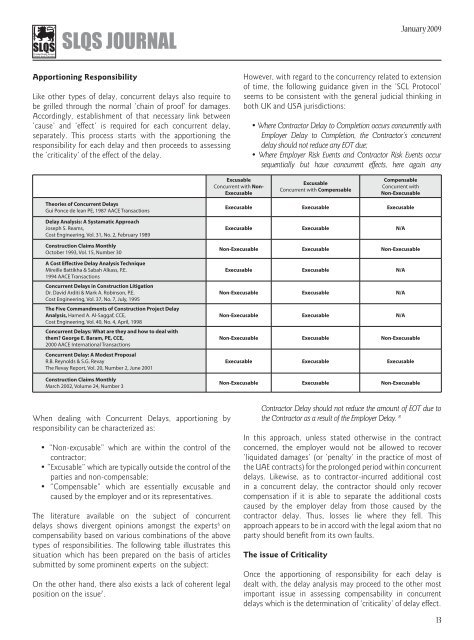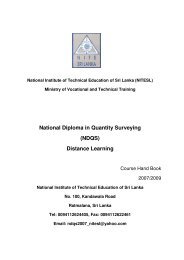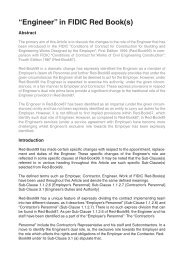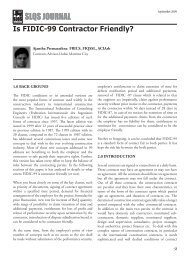SLQS-Journal Vol. 1 - Slqs-uae.org
SLQS-Journal Vol. 1 - Slqs-uae.org
SLQS-Journal Vol. 1 - Slqs-uae.org
You also want an ePaper? Increase the reach of your titles
YUMPU automatically turns print PDFs into web optimized ePapers that Google loves.
<strong>SLQS</strong> JOURNALJanuary 2009Apportioning ResponsibilityLike other types of delay, concurrent delays also require tobe grilled through the normal ‘chain of proof’ for damages.Accordingly, establishment of that necessary link between‘cause’ and ‘effect’ is required for each concurrent delay,separately. This process starts with the apportioning theresponsibility for each delay and then proceeds to assessingthe ‘criticality’ of the effect of the delay.However, with regard to the concurrency related to extensionof time, the following guidance given in the ‘SCL Protocol’seems to be consistent with the general judicial thinking inboth UK and USA jurisdictions:• Where Contractor Delay to Completion occurs concurrently withEmployer Delay to Completion, the Contractor’s concurrentdelay should not reduce any EOT due;• Where Employer Risk Events and Contractor Risk Events occursequentially but have concurrent effects, here again anyTheories of Concurrent DelaysGui Ponce de lean PE, 1987 AACE TransactionsDelay Analysis: A Systamatic ApproachJoseph S. Reams,Cost Engineering, <strong>Vol</strong>. 31, No. 2, February 1989Construction Claims MonthlyOctober 1993, <strong>Vol</strong>. 15, Number 30A Cost Effective Delay Analysis TechniqueMireille Battikha & Sabah Alkass, P.E.1994 AACE TransactionsConcurrent Delays in Construction LitigationDr. David Arditi & Mark A. Robinson, P.E.Cost Engineering, <strong>Vol</strong>. 37, No. 7, July, 1995The Five Commandments of Construction Project DelayAnalysis, Hamed A. Al-Saggaf, CCE,Cost Engineering, <strong>Vol</strong>. 40, No. 4, April, 1998Concurrent Delays: What are they and how to deal withthem? Ge<strong>org</strong>e E. Baram, PE, CCE,2000 AACE International TransactionsConcurrent Delay: A Modest ProposalR.B. Reynolds & S.G. RevayThe Revay Report, <strong>Vol</strong>. 20, Number 2, June 2001Construction Claims MonthlyMarch 2002, <strong>Vol</strong>ume 24, Number 3ExcusableConcurrent with Non-ExecusableExcusableConcurrent with CompensableCompensableConcurrent withNon-ExecusableExecusable Execusable ExecusableExecusable Execusable N/ANon-Execusable Execusable Non-ExecusableExecusable Execusable N/ANon-Execusable Execusable N/ANon-Execusable Execusable N/ANon-Execusable Execusable Non-ExecusableExecusable Execusable ExecusableNon-Execusable Execusable Non-ExecusableWhen dealing with Concurrent Delays, apportioning byresponsibility can be characterized as:• “Non-excusable” which are within the control of thecontractor;• “Excusable” which are typically outside the control of theparties and non-compensable;• “Compensable” which are essentially excusable andcaused by the employer and or its representatives.The literature available on the subject of concurrentdelays shows divergent opinions amongst the experts 6 oncompensability based on various combinations of the abovetypes of responsibilities. The following table illustrates thissituation which has been prepared on the basis of articlessubmitted by some prominent experts on the subject:On the other hand, there also exists a lack of coherent legalposition on the issue 7 .Contractor Delay should not reduce the amount of EOT due tothe Contractor as a result of the Employer Delay. 8In this approach, unless stated otherwise in the contractconcerned, the employer would not be allowed to recover‘liquidated damages’ (or ‘penalty’ in the practice of most ofthe UAE contracts) for the prolonged period within concurrentdelays. Likewise, as to contractor-incurred additional costin a concurrent delay, the contractor should only recovercompensation if it is able to separate the additional costscaused by the employer delay from those caused by thecontractor delay. Thus, losses lie where they fell. Thisapproach appears to be in accord with the legal axiom that noparty should benefit from its own faults.The issue of CriticalityOnce the apportioning of responsibility for each delay isdealt with, the delay analysis may proceed to the other mostimportant issue in assessing compensability in concurrentdelays which is the determination of ‘criticality’ of delay effect.13





